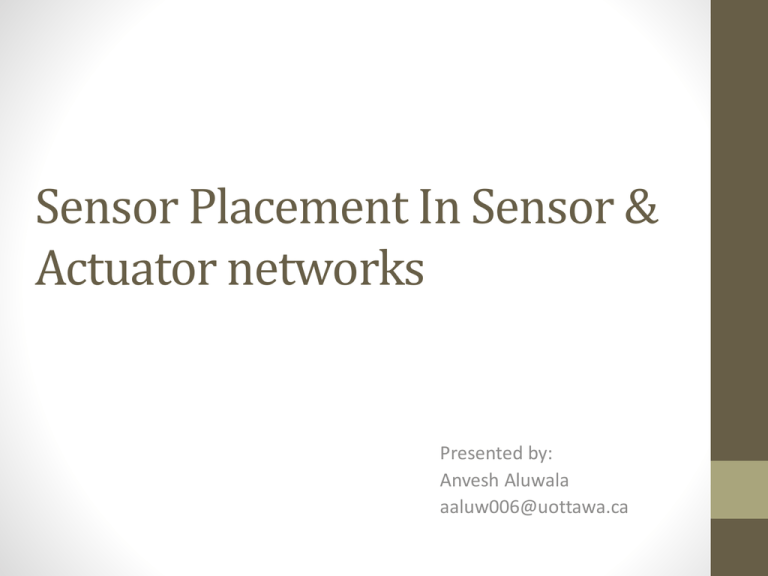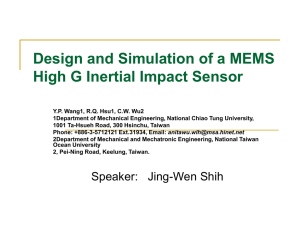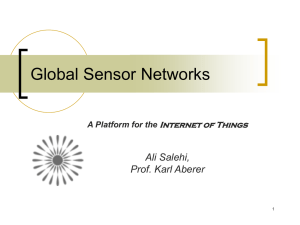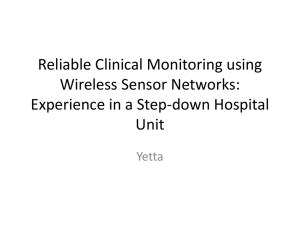Sensor Placement In Sensor & Actuator networks
advertisement

Sensor Placement In Sensor & Actuator networks Presented by: Anvesh Aluwala aaluw006@uottawa.ca Agenda • Introduction • Applications & Challenges • Problems and Sub-problems • Approaches for each sub problem • Conclusion • Questions Introduction What is WSAN? • Wireless Sensor and Actuator Networks • Contains a large number of self-sufficient nodes • Nodes have sensing capabilities, can perform simple computations and can communicate with each other[5] Importance of Coverage in Sensor Networks • Coverage is the basis of a sensor network • It will be ideal if the sensor covers the right region designated to it…but due to many problems this is not fully satisfied Applications & Challenges Applications • Environmental monitoring - which involves monitoring air soil and water, condition based maintenance[2] • Habitat monitoring[2] • Military surveillance • Smart spaces… Challenges • Ad hoc deployment • Dynamic changes… Problem Statement Movement Assisted Sensor Placement • In wireless sensor and actuator networks (WSAN), the impact on coverage from stochastic node dropping and unpredictable node failure, coupling with controlled node mobility, brings about the problem of movement-assisted sensor placement for coverage formation and improvement[1]. • There are different ways to place sensors by exploiting node mobility in WSAN. • Sensors can be placed by mobile actuators. • If sensors have locomotion, then they can place themselves by intelligently changing their geographic location without others’ help. Sub-problems[1] 1. Sensor placement by actuators 2. Coverage maintenance by actuators 3. Sensors self deployment 4. Sensor Relocation Basic points… Sensor placement by Actuators • Actuators serve as network installers for sensor deployment • They carry sensors along with them in ROI (Region Of Interest) • They deploy sensors at desired positions • Even in a case where ROI is bounded and where there are sufficient sensors, the problem is How to guide the actuators to explore entire ROI Basic points (contd..) Coverage maintenance by actuators • After initial sensor deployment, actuators can be used for further maintenance • They move and can drop new sensors in place of reported sensing holes • If actuators have no sensors in hand, then they have to first fetch spare sensors in the network and then proceed Basic points (contd..) Sensor self deployment • Sensor self-deployment takes place immediately after initial sensor dropping • To perform self-deployment, each sensor node needs to have locomotion Sensor relocation • Even this process needs locomotion • Involves two tasks: 1. replacement discovery 2. replacement migration Sensor placement by Actuators Least Recently Visited Approach: • A single-actuator-based sensor placement algorithm • Assumes equal sensing and communication radii and guides actuator movement according to the suggestion of previously deployed sensors • The algorithm starts with an empty environment • At initiation, the actuator (robot) deploys a node at its current position • Each deployed sensor maintains a set of directions along which the robot can move away from it • Directions could follow a graph structure (e.g. tree), or could be predefined (e.g. four geographical directions) • It also assigns a weight, initially equal to 0, to each direction, indicating the number of times that direction was traversed by the actuator Sensor placement by Actuators Least Recently Visited Approach: • Every sensor recommends its locally least recently visited direction to the actuator by message when the actuator is in its communication range • The actuator travels a pre-defined distance in recommended direction • If, however, the chosen direction is obstructed, it will inform the recommender and ask for a new suggested direction • Whenever the actuator departs or arrives, its current sensor increases the weight of its going-direction /coming-direction • The actuator remains at a location for a pre-defined short period of time before its next movement • During this period, if it receives no sensor message, it will drop a new sensor in the environment Least Recently Visited Approach EXAMPLE Picture taken from [1] Pros and Cons: • Localized algorithm, hence fault tolerant • Not clear when the algorithm terminates, because actuator do not have global view and always receives a direction from the sensor. • It may terminate when it has no sensors left Sensor placement by Actuators Snake like Deployment Approach: • SLD uses a single mobile actuator to deploy static sensors at vertices of an equilateral triangle tessellation (TT) constructed over a bounded rectilinear ROI • The only actuator moves like a snake, starting from the upperleft corner of the ROI • It moves to the right along a horizontal line and drops sensors at separation √3r until it hits the boundary of the ROI or an obstacle. • Then it moves a distance of √3/2 r down to the next horizontal line, change its moving direction to the left, and proceed similarly. • ‘r’ is the sensing range of the sensor Sensor placement by Actuators Snake like Deployment Approach: • The algorithm also attempts to avoid sensing holes hidden behind physical obstacles by allowing the actuator to break its regular movement pattern. • Specifically, the actuator checks, before its next movement step, whether there is any sensing hole in its vicinity in its coming direction. • If the answer is positive, it will change its moving direction toward that hole. • By this means, the actuator can move up and down, left and right along different lines, reducing the occurrence possibility of sensing holes. Snake like Deployment Approach EXAMPLE Picture taken from [1] Pros and Cons: • Again when does the algorithm terminate? • No full coverage in case of above example • Once any obstruction it cannot cover the region across the wall Voronoi diagram: Description • The Voronoi diagram of a collection of nodes partitions the space into polygons. • Every point in a given polygon is closer to the node in this polygon than to any other node. • Each sensor, represented by a number, is enclosed by a Voronoi polygon and these polygons together cover the target field. • The points inside one polygon are closer to the sensor inside this polygon than the sensors positioned elsewhere. • Thus, if this sensor cannot detect the expected phenomenon, no other sensor can detect it, and then each sensor is responsible for the sensing task in its Voronoi polygon. • In this way, each sensor can examine the coverage hole locally, and only needs to monitor a small area around it. • To construct the Voronoi polygon, each sensor only needs to know the existence of its Voronoi neighbors, which reduces the communication complexity. Coverage Maintenance by Actuators • It has not yet been well studied how to repair/maintain coverage using actuators. • Existing solutions are straightforward application of clustering and flooding with huge message overhead. • They work under the assumption that actors are carrying sufficient spare sensors. Cluster Based Approach • Addressed how to replace failed sensors in WSAN by presenting three straightforward actuator coordination protocols. Coverage Maintenance by Actuators Centralized protocol • An actuator is appointed as a central manager and responsible for handling node failure reports • The central controller broadcasts its location to all sensors and other actuators • It maintains the latest position of each actuator by listening to actuator location updates • Sensors monitor each other and report detected node failures to the central manager, which then dispatches closest actuators to replace failed sensors with their carried spare ones • First-come-first-serve basis for multiple requests • As an actuator moves to its assigned failure location, it keeps updating the central manager with its latest position Coverage Maintenance by Actuators Distributed protocol • The sensory field is partitioned into equal-sized sub-regions • Each actuator is assigned one and only one sub-region and required to handle regional node failure reports as manager • It is also responsible for sensor replacement in its own sub-region • The centralized algorithm is then run within each sub-region Dynamic protocol • The sensory field is dynamically partitioned according to the current position of each robot • Specifically, each robot broadcasts its current location, sensors receiving messages from multiple robots rebroadcast only the one from closest robot • Finally, a Voronoi diagram is constructed based on hop count • Nodes report detected sensor failures to the creating actuators of their home Voronoi cells, which then move to replace the failed sensor with their carried spare ones • While moving, actuators broadcast their latest location to update the Voronoi diagram Coverage Maintenance by Actuators Perimeter Based Approach • In this solution, actuators are required to form a connected network • To obtain such a network, actuators can be densely dropped in a small region first and then spread by a vector-based self-deployment approach • Actuators locally construct a Gabriel over the actuator network. • When a sensor detects a sensing hole, which is represented by a geographic point, it sends a report to any one of the actuators by anycasting • The actuator receiving the report, which is not necessarily the closest one to the reporting sensor, routes a message toward the sensing hole through Greedy- Face-Greedy routing (GFG) protocol over the actuator network Coverage Maintenance by Actuators Perimeter Based Approach • Lack of destination information causes failure in routing process, hence the message will make a cycle around that sensing hole on Gabriel graph and stop at the actuator closest to it. • This actuator will take the responsibility to fill the reported sensing hole. Sensor Self-Deployment: Motivation Sensor dropping for aircrafts Picture taken from [8] Sensor Self-Deployment: Motivation Emergency environment monitoring Picture taken from [8] Sensor Self-Deployment: Motivation Another emergency application Picture taken from [8] Sensor Self-Deployment Virtual Forces: The Basics • Many different implementations of this technique have been proposed • The best known sensor self-deployment approach is probably the virtual force/vector based approach • Inspired by a variety of physical models, e.g. potential fields, molecules, electro-magnetic particles… • The core idea is the same. It is motivated by the attributes of electro-magnetic particles i.e. when two electro-magnetic particles are too close to each other, an expelling force pushes them apart Sensor Self-Deployment Virtual Force/Vector Based Approach • Assume d(si, sj) is the distance between sensor si and sensor sj • d.avg is the average distance between two sensors when the sensors are evenly distributed in the target area, which can be calculated beforehand since the target area and the number of sensors to be deployed are known • The virtual force between two sensors si and sj will push them to move (d.avg − d(si, sj))/2 away from each other. • In case one sensor covers its Voronoi polygon completely and should not move, the other sensor will be pushed d.avg − d(si, sj) away. • In summary, the virtual force will push the sensors d.avg away from each other if coverage hole exists in either of their Voronoi polygons. Sensor Self-Deployment Virtual Force/Vector Based Approach • In addition to the virtual forces generated by sensors, the field boundary also exert forces, denoted as Fb, to push sensors too close to the boundary inside. • Fb exerted on si will push it to move d.avg/2−db(si), where db(si) is the distance of si to the boundary. • Since d.avg is the average distance between sensors, d.avg/2 is the distance from the boundary to the sensors closest to it when sensors are evenly distributed. Snapshot execution of Vector based • Snapshots for vector based/virtual force approach • Picture taken from [3] Vector based approach EXAMPLE Pros and Cons: • Enables nodes to make their deployment decision using solely their local knowledge • Sensors can not pass through closely placed obstacles due to their generated repulsive vector, resulting in sensing holes and coverage waste. Sensor Self-Deployment Voronoi Based Approach • The idea of Voronoi-based self-deployment is simple: sensors move to minimize their local uncovered areas (equivalently speaking, to maximize their sensing-effective areas) by aligning their sensing range with their Voronoi regions as much as possible. • Usually, this approach involves multiple rounds of alignment and terminates when no more gain can be achieved Voronoi based approach • Picture taken from [3] • Compared to the Vector based algorithm, VOR is a pull-based algorithm which pulls sensors to their local maximum coverage holes. • In VOR, if a sensor detects the existence of coverage holes, it will move toward its farthest Voronoi vertex • The small white circles represent si’s Voronoi neighbors and the large circle represents the sensing circle. • Point A is the farthest Voronoi vertex of si and d(A, si) is longer than the sensing range. • Sensor si moves along line siA to Point B, where d(A,B) is equal to the sensing range. • We limit the maximum moving distance to be at most half of the communication range Voronoi based approach EXAMPLE Snapshot of voronoi based approach Picture taken from [3] Sensor Self-Deployment Many other…[1] Load-balancing approach: • The number of sensors in the regions of a partitioned sensor field is balanced through multiple rounds of scans Stochastic approach: • Sensors spread out through random walk Point-coverage approach: • The area coverage problem is converted to a point coverage problem over certain geographic graph Incremental approach: • Sensors are deployed incrementally, i.e., one at a time, based on the information gathered from previously deployed sensors Sensor Relocation Mobile Sensor Migration • After a mobile sensor makes its decision for self-deployment or relocation, it will migrate from its current position to the target position. • Two ways: Direct way and Shifted manner. • In direct migration, the sensor simply moves all the way to the target location • In shifted migration, a multi-hop migration path is built from the sensor to the target location • Every sensor along this path shifts its position by one hop toward the target location. • The last sensor in the path moves to the target location. Mobile Sensor Migration EXAMPLE: shifted migration method… Sensor Relocation Two steps: 1. Replacement Discovery 2. Replacement Migration • To minimize energy consumption and response time, a replacement node should be a redundant sensor geographically closest to the failed node. • Thus replacement discovery is a distance-sensitive service discovery problem, where redundant sensors offers replacement service to failed sensors. • After replacement discovery, discovered replacement will be migrated to the position of failed sensor. Sensor Relocation • Many service discovery have been proposed for wireless ad hoc networks. They can certainly be used to fulfill the replacement discovery problem • Some techniques such as location and data centric storage can also be adopted • By location service, redundant sensors update the network with their location and are searched when needed • By data centric storage, the location data of redundant sensors are stored somewhere in the network and retrieved by others • But, considering the resource constraints of sensors, a good solution should have low message overhead and constant per node storage load • Example approaches are Broadcast-based approach, Meshbased approach, etc. Conclusion • Stated the Movement Assisted Sensor Placement problem, also its sub problems • Different approaches for all the sub problems • Pros and cons for the approaches • There are even more approaches but there is no systematic study on them • Now-a-days Sensor self-deployment area is being researched more since it has more applications than others References • [1] Amiya Nayak and Ivan Stojmenovic, “Wireless Sensor and Actuator Networks-Algorithms and protocols for Scalable Coordination and Data Communication”. • [2] Archana Bharathidasan and Vijay Anand Sai Ponduru, “Sensor Networks: An Overview”. • [3] Guiling Wang, Guohong Cao and Tom La Porta “MovementAssisted Sensor Deployment” • [4] panda.ece.utk.edu/w/images/2/23/Sensordeployment.ppt “Optimal Self-placement of Heterogeneous Mobile Sensors in Sensor Networks. • [5] www.cs.berkeley.edu/~culler/cs252-s02/slides/lec08wireless.ppt “Wireless Sensor Networks” • [6] www.site.uottawa.ca/~casteig/files/csi5140-shafagh-alikhani.ppt “Localization in Wireless Sensor Networks” • [7] Yi Zou, KrishnenduChakrabarty, ”Sensor Deployment and Target Localization Based on Virtual Forces” IEEE INFOCOM 2003 • [8] Rafael Falcon, “Robotic Sensor Wireless Networks” Questions Question 1: Consider Sensor placement by Actuators, In a snake like deployment approach if there is an obstacle in between as shown below. Whether full coverage is possible? If so Why(show with help of diagram)? Ans: No. Questions Question 2: In which way “shifted migration method” is better than “direct way” when we try to perform sensor relocation? Ans: For better network lifetime Shifted migration follows a multi-hop migration path, where every sensor involved shifts one position closer towards the target location. Since this method involves multiple nodes, it distributes energy consumption to all the nodes involved extending the network lifetime Questions Question 3: In case of Voronoi based approach, we limit the maximum moving distance for the sensor to be at most half of the communication range to avoid the situation shown below. Why? Ans: • In above situation si is not aware of the existence of sj because of communication limitations, and its local view of Gp(si) (shown in the dotted line) is not correct (shown in the solid line). • Otherwise, if si moves toward point A and stops at a distance d(A,B) (sensing range), then si has obviously moved more than needed. Thank You!








